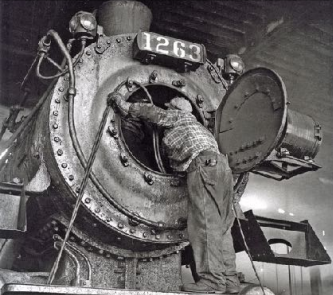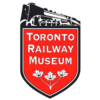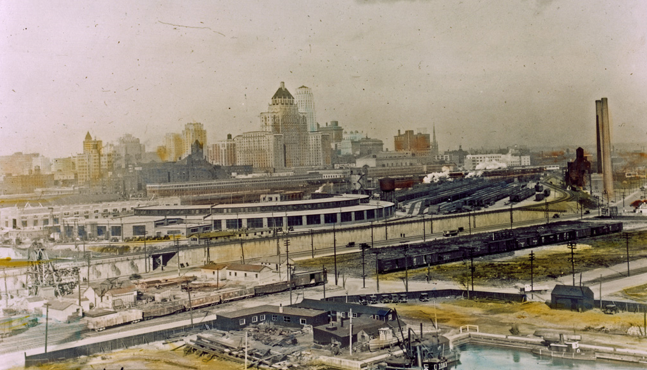This month marks the John Street Roundhouse’s anniversary – an occasion we like to celebrate every year! Keep reading to discover the story of the unique National Historic Site the Toronto Railway Museum calls home.
On October 15, 1929, Canadian Pacific Railway’s John Street Roundhouse officially opened. As one of Canadian Pacific’s largest roundhouses, it operated in the heart of Toronto for almost 60 years. Today, the Toronto Railway Museum is inside three of the service stalls.
Notably, the Roundhouse complex had hosted over forty other buildings. For example, the largest turntable in Canada (measuring 120 feet long!), linen stores for stocking outbound passenger trains, and administrative buildings set among the tracks. Servicing Canadian Pacific Railway (CPR) passenger trains took an around-the-clock effort. Thanks to the network of railway buildings and structures, this endeavour was possible.
A Growing Demand
The original John Street Roundhouse, built in 1897, was too small for CPR’s activities. To keep up with the growing freight and passenger demand in Canada, many railway companies began developing larger locomotives. For instance, our Canadian National No 6213 is a huge Northern-type locomotive. Consequently, with the increasing size of locomotives and the rapid growth of the railway industry, repair facilities adapted too.
Construction of the present day Roundhouse began in 1925, with the majority of the stalls built by 1929. Then, by 1931, construction of the roundhouse with its full complement of 32 stalls was complete.
Workers at the John Street Roundhouse
With over 100 people working at the Roundhouse daily, the workers were kept busy by maintaining and preparing steam locomotives. Locomotives leaving the Roundhouse had what was known as the “John Street polish”. In other words, the locomotives serviced at the John Street Roundhouse were so attractively maintained that their appearance became known among railroaders. In the story of the John Street Roundhouse, CPR steam locomotives are serviced there for over thirty years.

End of an Era
However, in the late 1930’s, diesel-electric power was replacing steam locomotives. This change began mostly in urban areas where the noxious clouds of coal smoke were unpopular with city dwellers. Additionally, a steam-powered engine required at least two people to operate (an engineer and a fireman) and would spend eight hours or more in servicing. Above all, the emerging diesel technology was much more efficient. Therefore, railway companies were able to cut staffing and maintenance costs by switching to a diesel-powered fleet.
CPR’s steam engines fully retired in 1960. Next John Street continued to service CPR and VIA Rail diesel-electric locomotives for another twenty years until 1986 when the CPR decided to close the facility. After that, the City of Toronto acquired it for use as a railway museum. In 1988, all activity at the John Street Roundhouse ceased. During this time, the Roundhouse building was sitting vacant among the developing rail lands.
The Roundhouse Today
Today, there is a hint of the original Roundhouse activity inside of the John Street Roundhouse. For example, it is thanks to our team of museum volunteers that Stall 15 of the roundhouse is an active restoration area. Most importantly, it is where our rolling stock maintenance occurs. The cars and locomotives in our collection will receive hours of our volunteers’ attention inside. Our volunteers do it all! For example, they work laying floor boards and stripping paint, to re-wiring and carefully restoring heritage features. You can see what our volunteers are up to by following along on Instagram, Twitter, and Facebook.
In conclusion, the Toronto Railway Museum is a volunteer-run organization! We have a great crew of volunteers who assist staff and support the Museum in a wide range of activities.
See the specific open opportunities listed on the volunteer page of our website.


Many thanks for the most interesting article. And the photos are excellent.